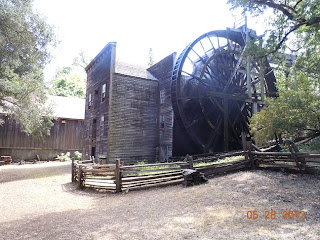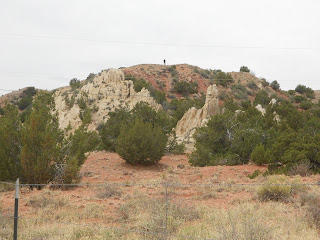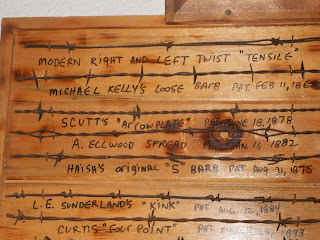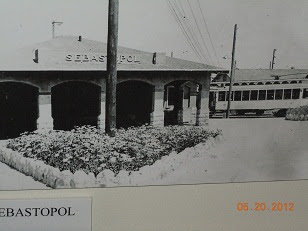 |
| We Can Do It poster |
The National Park Service project of the Rosie the Riveter
World War Two Memorial is alive and well in Richmond California. On a recent visit to the new Visitor Center I was very impressed with the exhibits on display. You'll find a trip there very interesting with a lot of information you may not have been aware of.
The
We Can Do It poster at left has been popular for decades. It stands as a symbol of Rosie the Riveter. This particular poster was created by
J. Howard Miller who was employed by Westinghouse's War Production Coordinating Committee to create several posters for the war effort.
Rosie the Riveters of World War Two
Because of
Rosie the Riveter, the United States was able to produce the materials of war needed to win World War Two. Who was Rosie the Riveter? In actuality, there were thousands and thousands of
Rosie the Riveters working in factories all across the U.S. With the available male workforce reduced, Rosie the Riveters filled this void. The statistics are quite revealing. During the peak war years, it was estimated that women made up 27 percent of the Kaiser Shipyard workforce. Women made up some 80 percent of the workforce in other industries. Rosie the Riveters were crucial to this country's war effort during the early 40's.
As part of honoring the work done so many decades ago by this essential female workforce, the National Park Service is introducing the
Rosie the Riveter World War II Home Front National Historical Park. This World War Two Memorial park is located on the waterfront in Richmond California, just across the bay from San Francisco. The park is an ongoing project for the NPS. This unique park serves, among other things, as a World War 2 memorial. The park is located at the site of the old
Kaiser Shipyards. I had the opportunity of attending the grand opening of the
Rosie the Riveter Visitor Center and it's a great place to visit. If you're visiting the San Francisco Bay area, you will want to add this to your trip planner. There is just an incredible amount of history being displayed at this new NPS venue. The World War 2 vintage artifacts are many.
Rosie the Riveter Museum...A Must Stop
 |
| Richmond,CA Ford Motor assembly plant |
The exhibits in this well laid out Visitor Center, which is in essence a World War Two museum, are really one of a kind. The vintage posters and photos of the era are displayed all along the walls with authentic artifacts displayed in glass cases. Just to mention a few of the many exhibits are authentic welding masks, gloves, hard hats, riveting tools, a very informative video explaining what it was like for war
production workers in Richmond California during the early 1940's. All exhibits are the real thing.
Everything about this well planned World War Two Memorial park is centered on the home front during World War Two in general and the San Francisco Bay area and the Richmond war production facilities in particular.
Adjacent to the Rosie the Riveter Visitor Center is the old
50,000 square foot Ford Motor Company assembly plant which during the war was turned into a tank and military vehicle production facility. The official figures released were that some 49,000 jeeps were built there as well as 91,000 other military related vehicles including 60,000 tanks. The old Ford plant is also on the Richmond waterfront. It was closed in 1956. Today, when you visit this old factory you'll enter a very large area on the water side which can accommodate large functions and
displays related World War Two exhibits. The old
Ford assembly plant is listed on the National Register of Historic Places.
The Red Oak Victory Ship
 |
| Rosie the Riveter Nat'l Park Visitor Center |
In addition to the World War Two museum at the Visitor's Center is the
Red Oak Victory Ship docked at Point Richmond, just a few minutes from the Visitor Center itself.
You really want to take a guided tour of this legendary ship to appreciate it's full history. Your Red Oak Victory Ship tour will essentially take you through the entire ship, including the bridge, with very good interpretive talks along the way.Within the lower large cargo hold area are a large amount of fascinating exhibits and an interesting gift shop.
The
Victory Ships were along the same lines as the famous Liberty Ships however the major differences were that the Victory Ships were a bit larger and the hulls were more strengthened and more were produced. The Liberty Ship basic design was used to build the Victory Ships. In essence, the Victory Ships enhanced the Liberty Ship attributes.
 |
| Red Oak Victory Ship |
The
Rosie the Riveter World War Two Memorial is one of the very best I've seen. It's purpose is
honoring American Women's labor during the Second World War.
Many historians and others have pointed out how World War II so dramatically changed the San Francisco Bay area and northern California. The economic impact on the region has been compared to the Gold Rush days of the 1850's. Richmond California itself went from a small town to a booming war production venue almost overnight. In some ways quite similar to how gold mining camps exploded into full fledged towns overnight.
Following are links to two short articles regarding the home front during World War Two.
San Francisco WW II Defenses and
Galveston's World War Two Action.
The link for
Rosie the Riveter Home Front National Park.
I hope you have a chance to visit this very unique new National Park.
(Photos are from author's private collection)
Directions from the Oakland/San Francisco area:
Interstate 80 East.
Exit to I-580 West towards Richmond/San Rafael.
Exit Marina Bay/South 23rd Street.
Turn left (over the freeway overpass), drive approx. 1/2 mile.
Turn right onto Regatta.
Turn first left at Melville into the parking lot of Marina Bay Park.
If you're driving from Sacramento:
Interstate 80 West.
Exit on Cutting Blvd., drive approx. 1 1/3 miles.
Turn left on 23rd Street.
Turn right onto Regatta.
Turn first left at Melville into the parking lot of Marina Bay Park.
View Larger Map





































